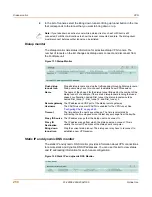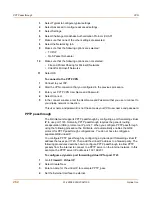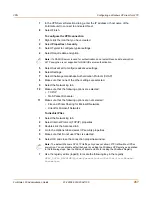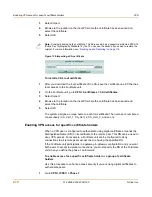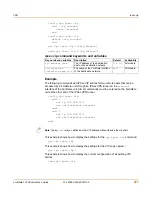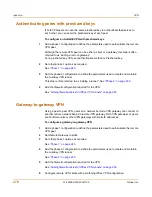
268
01-28006-0003-20041105
Fortinet Inc.
Configuring a Windows XP client for L2TP
VPN
8
Add the following registry value to this key:
Value Name: ProhibitIPSec
Data Type: REG_DWORD
Value: 1
9
Save your changes and restart the computer for the changes to take effect.
You must add the
ProhibitIPSec
registry value to each Windows XP-based
endpoint computer of an L2TP or IPSec connection to prevent the automatic filter for
L2TP and IPSec traffic from being created. When the
ProhibitIPSec
registry value
is set to 1, your Windows XP-based computer does not create the automatic filter that
uses CA authentication. Instead, it checks for a local or active directory IPSec policy.
To connect to the L2TP VPN
1
Connect to your ISP.
2
Start the VPN connection that you configured in the previous procedure.
3
Enter your L2TP VPN User Name and Password.
4
Select Connect.
5
In the connect window, enter the User Name and Password that you use to connect to
your dialup network connection.
This user name and password is not the same as your VPN user name and password.
Certificates
Digital certificates are downloadable files that you can install on the FortiGate unit and
its remote peers to support IPSec VPNs. Digital certificates can be used to
authenticate IPSec VPN peers. A digital certificate consists of a private key, a public
key, and some identifying information that has been digitally signed by a trusted third
party known as a certificate authority (CA). Because CAs can be trusted, the
certificates issued by a CA are deemed to be trustworthy.
To obtain a personal or site certificate, you must send a request to a CA that provides
digital certificates that adhere to the X.509 standard. The FortiGate unit provides a
way for you to generate the request. The generated request includes information such
as the FortiGate unit’s public static IP address, domain name, or email address.
In return, the CA will verify the information and register the contact information on a
digital certificate that contains a serial number, an expiration date, a private key, and a
public key. The CA will then send the digital certificate to you to install on the
FortiGate unit. You must also obtain and install the CA’s root certificate on the
FortiGate unit.
After the required personal or site certificates and root certificates have been installed
on the VPN peers, they identify themselves during phase 1 negotiations using
certificates. The FortiGate unit provides its public key to the remote peer so that the
remote peer can send encrypted messages to the FortiGate unit. The private key is
kept secret on the FortiGate unit for decrypting messages sent by the remote peer.
Conversely, the remote peer provides its public key to the FortiGate unit, which uses
the key to encrypt messages destined for the remote peer.
Summary of Contents for FortiGate 100
Page 24: ...24 01 28006 0003 20041105 Fortinet Inc FortiLog documentation Introduction ...
Page 72: ...72 01 28006 0003 20041105 Fortinet Inc Transparent mode VLAN settings System network ...
Page 80: ...80 01 28006 0003 20041105 Fortinet Inc DHCP IP MAC binding settings System DHCP ...
Page 114: ...114 01 28006 0003 20041105 Fortinet Inc Access profile options System administration ...
Page 232: ...232 01 28006 0003 20041105 Fortinet Inc CLI configuration Firewall ...
Page 244: ...244 01 28006 0003 20041105 Fortinet Inc peergrp Users and authentication ...
Page 320: ...320 01 28006 0003 20041105 Fortinet Inc service smtp Antivirus ...
Page 366: ...366 01 28006 0003 20041105 Fortinet Inc syslogd setting Log Report ...
Page 380: ...380 01 28006 0003 20041105 Fortinet Inc Glossary ...
Page 388: ...388 01 28006 0003 20041105 Fortinet Inc Index ...





